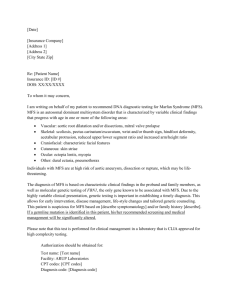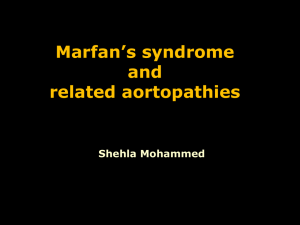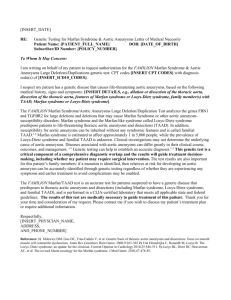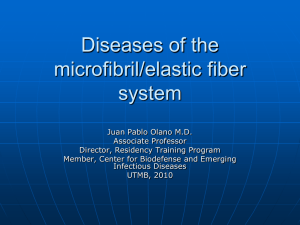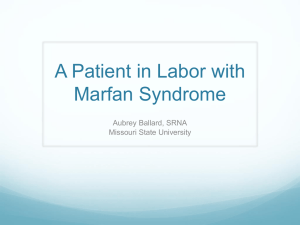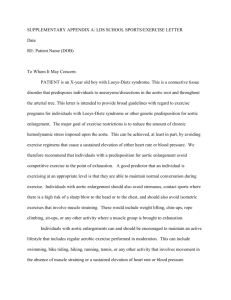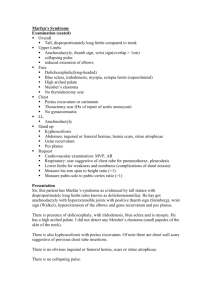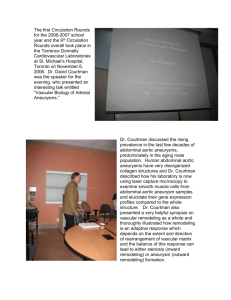Genetic Testing for Marfan Syndrome, Thoracic Aortic
advertisement
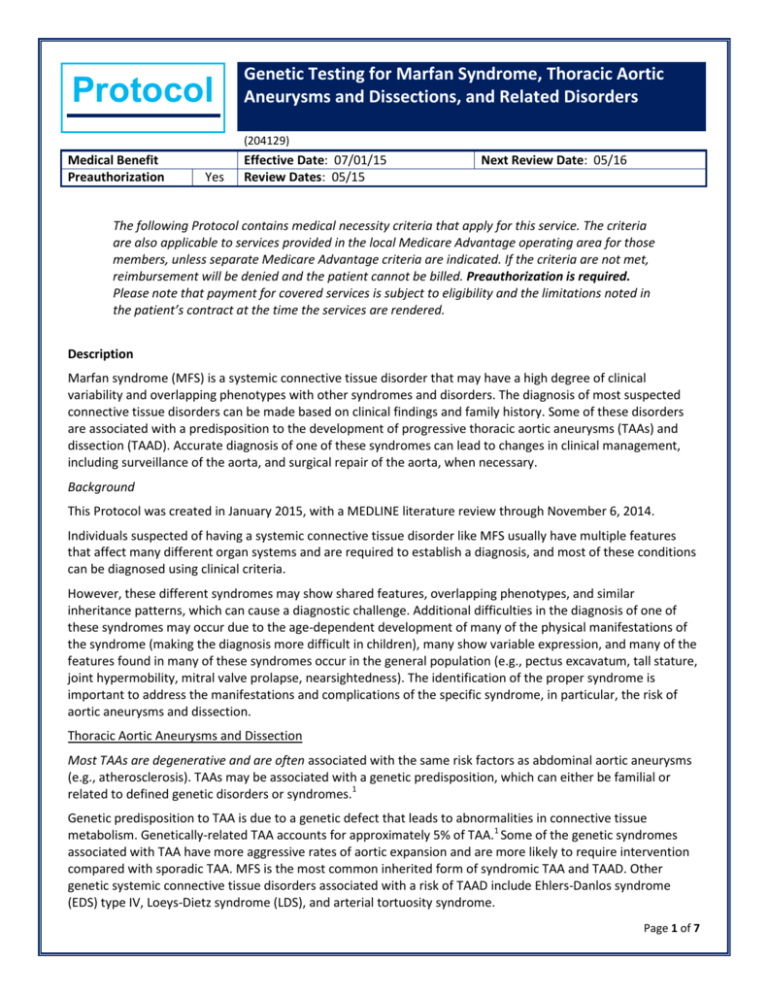
Protocol Genetic Testing for Marfan Syndrome, Thoracic Aortic Aneurysms and Dissections, and Related Disorders (204129) Medical Benefit Preauthorization Yes Effective Date: 07/01/15 Review Dates: 05/15 Next Review Date: 05/16 The following Protocol contains medical necessity criteria that apply for this service. The criteria are also applicable to services provided in the local Medicare Advantage operating area for those members, unless separate Medicare Advantage criteria are indicated. If the criteria are not met, reimbursement will be denied and the patient cannot be billed. Preauthorization is required. Please note that payment for covered services is subject to eligibility and the limitations noted in the patient’s contract at the time the services are rendered. Description Marfan syndrome (MFS) is a systemic connective tissue disorder that may have a high degree of clinical variability and overlapping phenotypes with other syndromes and disorders. The diagnosis of most suspected connective tissue disorders can be made based on clinical findings and family history. Some of these disorders are associated with a predisposition to the development of progressive thoracic aortic aneurysms (TAAs) and dissection (TAAD). Accurate diagnosis of one of these syndromes can lead to changes in clinical management, including surveillance of the aorta, and surgical repair of the aorta, when necessary. Background This Protocol was created in January 2015, with a MEDLINE literature review through November 6, 2014. Individuals suspected of having a systemic connective tissue disorder like MFS usually have multiple features that affect many different organ systems and are required to establish a diagnosis, and most of these conditions can be diagnosed using clinical criteria. However, these different syndromes may show shared features, overlapping phenotypes, and similar inheritance patterns, which can cause a diagnostic challenge. Additional difficulties in the diagnosis of one of these syndromes may occur due to the age-dependent development of many of the physical manifestations of the syndrome (making the diagnosis more difficult in children), many show variable expression, and many of the features found in many of these syndromes occur in the general population (e.g., pectus excavatum, tall stature, joint hypermobility, mitral valve prolapse, nearsightedness). The identification of the proper syndrome is important to address the manifestations and complications of the specific syndrome, in particular, the risk of aortic aneurysms and dissection. Thoracic Aortic Aneurysms and Dissection Most TAAs are degenerative and are often associated with the same risk factors as abdominal aortic aneurysms (e.g., atherosclerosis). TAAs may be associated with a genetic predisposition, which can either be familial or related to defined genetic disorders or syndromes.1 Genetic predisposition to TAA is due to a genetic defect that leads to abnormalities in connective tissue metabolism. Genetically-related TAA accounts for approximately 5% of TAA.1 Some of the genetic syndromes associated with TAA have more aggressive rates of aortic expansion and are more likely to require intervention compared with sporadic TAA. MFS is the most common inherited form of syndromic TAA and TAAD. Other genetic systemic connective tissue disorders associated with a risk of TAAD include Ehlers-Danlos syndrome (EDS) type IV, Loeys-Dietz syndrome (LDS), and arterial tortuosity syndrome. Page 1 of 7 Protocol Genetic Testing for Marfan Syndrome, Thoracic Aortic Aneurysms and Dissections, and Related Disorders Last Review Date: 05/15 Familial TAAD refers to patients with a family history of aneurysmal disease, but who do not meet criteria for a connective tissue syndrome. Marfan Syndrome MFS is an autosomal dominant condition, in which there is a high degree of clinical variability of systemic manifestations, ranging from isolated features of MFS to neonatal presentation of severe and rapidly progressive disease in multiple organ systems.2 Despite the clinical variability, the principal manifestations involve the skeletal, ocular and cardiovascular systems. Involvement of the skeletal system is characterized by bone overgrowth and joint laxity, disproportionately long extremities for the size of the trunk (dolichostenomelia), overgrowth of the ribs which can push the sternum in or out (pectus excavatum or carinatum, respectively), and scoliosis which can be mild or severe and progressive. Ocular features include myopia, and displacement of the lens from the center of the pupil (ectopic lentis) is a hallmark feature and seen in 60% of affected individuals. Cardiovascular manifestations are the major source of morbidity and mortality and include dilation of the aorta at the level of the sinuses of Valsalva, predisposition for aortic tear and rupture, mitral valve prolapse, tricuspid valve prolapse and enlargement of the proximal pulmonary artery. However, with proper management, the life expectancy of someone with MFS can approximate that of the general population. The diagnosis of MFS is mainly a clinical one and based on the characteristic findings in multiple organ systems, as well as the family history.3 The Ghent criteria, revised in 2010, are used for the clinical diagnosis of MFS.3 The previous Ghent criteria had been criticized for taking insufficient account of the age-dependent nature of some of the clinical manifestations, making the diagnosis in children more difficult, and for including some nonspecific physical manifestations or poorly validated diagnostic thresholds. The revised criteria were based on clinical characteristics in large published patient cohorts, and expert opinions of panel members with extensive experience in application of the criteria, the differential diagnosis of MFS, and the strengths and limitations of molecular genetic testing.3 The revised criteria have five major changes to the previous diagnostic guidelines. First, more weight is given to the two cardinal features of MFS, aortic root aneurysm/dissection and ectopic lentis. In the absence of findings that are not expected in MFS, the combination of these two features is sufficient to make the diagnosis. When aortic disease is present, but ectopia lentis is not, all other cardiovascular and ocular manifestations of MFS and findings in other organ systems contribute to a “systemic score” that guides diagnosis. Second, a more prominent role has been given to molecular testing of FBN1 and other relevant genes, allowing for the appropriate use when necessary. Third, some of the less specific manifestations of MFS were removed or made less influential in the diagnostic criteria. Fourth, the revised criteria formalize the concept that additional diagnostic considerations and testing may be required if a patient has findings that satisfy the criteria for MFS but show unexpected findings, particularly if they are suggestive of a specific alternative diagnosis. Particular emphasis is placed on LDS, Sphrintzen-Goldberg syndrome (SGS), and EDSvascular type. LDS and SGS may have substantial overlap with MFS, including the potential for similar involvement of the aortic root, skeleton, skin and dura. EDS-vascular type occasionally shows overlap with MFS. Each of these conditions has a unique risk profile and management protocol.3 Given the autosomal dominant inheritance, the number of physical findings needed to establish a diagnosis for someone with an established family history is reduced. It is estimated that molecular techniques allow the detection of FBN1 mutations in up to 97% of Marfan patients who fulfil Ghent criteria, suggesting that the current Ghent criteria have excellent specificity.3 FBN1 is the only gene in which mutations are known to cause classic MFS. Approximately 75% of individuals with MFS have an affected parent, and 25% have a de novo mutation. Over 1000 FBN1 mutations that cause MFS have been identified. The following findings in FBN1 molecular genetic testing should infer causality in making the diagnosis of MFS: a pathogenic variant previously shown to segregate in families with MFS and de novo Page 2 of 7 Protocol Genetic Testing for Marfan Syndrome, Thoracic Aortic Aneurysms and Dissections, and Related Disorders Last Review Date: 05/15 mutations of a certain type (e.g., nonsense, certain missense mutations, certain splice site mutations, certain deletions and insertions).2 Most mutations in the FBN1 gene that cause MFS can be identified with sequence analysis (≈ 70% to 93%) and, although the yield of deletion/duplication analysis in patients without a defined coding sequence or splice site by sequence analysis is unknown, it is estimated to be about 30%. The most common testing strategy of a proband suspected of having MFS is sequence analysis followed by deletion/duplication analysis if a pathogenic variant is not identified.2 However, the use of genetic testing for a diagnosis of MFS has limitations. More than 90% of mutations that have been described are unique, and most mutations are not repeated among nongenetically related patients. Therefore, the absence of a known mutation in a patient in whom MFS is suspected does not exclude the possibility that the patient has MFS. No clear genotype-phenotype correlation exists for MFS and, therefore the severity of the disease cannot be predicted from the type of mutation. Caution should be used in interpreting the identification of a FBN1 mutation, as other conditions with overlapping phenotypes with MFS can have an FBN1 mutation (e.g., MASS syndrome, familial mitral valve prolapse syndrome, SGS, isolated ectopic lentis). Management of MFS includes both treatment of manifestations and prevention of complications, including surgical repair of the aorta depending on the maximal measurement, the rate of increase of the aortic root diameter, and the presence of progressive and severe aortic regurgitation. Ehlers-Danlos Syndrome EDS are a group of disorders that affect connective tissue disorders and share common features characterized by skin hyperelasticity or laxity, abnormal wound healing, and joint hypermobility. The defects in connective tissues can vary from mildly loose joints to life-threatening complications. All types of EDS affect the joints and many affect the skin, but features vary by type. The different types of EDS include types I and II (classic type), type III (hypermobility type), type IV (vascular type), type VI (kyphoscoliotic form), all of which are inherited in an autosomal dominant pattern with the exception of type VI, which is autosomal recessive. It is estimated that affected individuals with types I, II or IV may inherit the disease-causing mutation from an affected parent 50% of the time, and about 50% have a de novo disease-causing mutation. Most types of EDS are not associated with aortic dilation, with the exception of the vascular type (also known as type IV), which can involve serious and potentially life-threatening complications. The prevalence of the vascular type may affect about one in 250,000 people. Vascular complications include rupture, aneurysm, and/or dissection of major or minor arteries. Arterial rupture may be preceded by aneurysm, arteriovenous fistulae or dissection, or may occur spontaneously. Such complications are often unexpected and may present as sudden death, stroke, internal bleeding and/or shock. The vascular type is also associated with an increased risk of gastrointestinal perforation or organ rupture, and rupture of the uterus during pregnancy. The clinical diagnosis of EDS type IV can be made from major and minor clinical criteria. The combination of two major criteria (arterial rupture, intestinal rupture, uterine rupture during pregnancy and a family history of EDS type IV) is highly specific.4 The presence of one or more minor clinical criteria supports the diagnosis, but is not considered sufficient to make the diagnosis. Mutations in the ADAMTS2, COL1A1, COL1A2, COL3A1, COL5A1, COL5A2, PLOD1, and TNXB genes cause EDS. The vascular type (type IV) is caused by mutations in the COL3A1 gene. Loeys-Dietz Syndrome LDS is an autosomal dominant condition that is characterized by four major groups of clinical findings, including Page 3 of 7 Protocol Genetic Testing for Marfan Syndrome, Thoracic Aortic Aneurysms and Dissections, and Related Disorders Last Review Date: 05/15 vascular, skeletal, craniofacial, and cutaneous manifestations. Vascular findings include cerebral, thoracic, and abdominal arterial aneurysms and/or dissections. Skeletal findings include pectus excavatum or carinatum, scoliosis, joint laxity, arachnodactyly and talipes equinovarus. The natural history of LDS is characterized by arterial aneurysms, with a mean age of death of 26 years and a high incidence of pregnancy-related complications, including uterine rupture and death. Treatment considerations take into account that aortic dissection tends to occur at smaller aortic diameters than MFS, and the aorta and its major branches can dissect in the absence of much, if any, dilation. Patients with LDS require echocardiography at frequent intervals, to monitor the status of the ascending aorta, and angiography evaluation to image the entire arterial tree. LDS is caused by mutations in TGFBR1, TGFBR2, TGFB2, and SMAD3. Arterial Tortuosity Syndrome Arterial tortuosity syndrome is inherited in an autosomal recessive pattern and is characterized by tortuosity of the aorta and/or large- and middle-sized arteries throughout the body. Aortic root dilation, stenosis and aneurysms of large arteries are common. Other features of the syndrome include joint laxity and hyperextensible skin. The syndrome is caused by mutations in the SLC2A10 gene. Familial TAAD Approximately 80% of familial TAA and TAAD is inherited in an autosomal-dominant manner and may be associated with variable expression and decreased penetrance of the genetic mutation. The major cardiovascular manifestations of familial TAAD (fTAAD) include dilatation of the ascending thoracic aorta at the level of the sinuses of Valsalva or ascending aorta or both and dissections of the thoracic aorta involving either the ascending or descending aorta.5 In the absence of surgical repair of the ascending aorta, affected individuals have progressive enlargement of the ascending aorta, leading to acute aortic dissection. Presentation of the aortic disease and the age of onset are highly variable. fTAAD is diagnosed based on the presence of thoracic aorta pathology, absence of clinical features of MFS, LDS, or vascular EDS, and a positive family history of TAAD. fTAAD is associated with mutations in TGFBR2, TGFBR1, MYH11, ACTA2, MYLK, SMAD3, and two loci on other chromosomes, AAT1 and AAT2. Rarely, fTAAD can also be caused by FBN1 mutations. To date, only about 20% of fTAAD is accounted for by mutations in known genes. Early prophylactic repair should be considered in individuals with confirmed mutations in TGFBR2 and TGFBR1 and/or a family history of aortic dissection with minimal aortic enlargement. The following syndromes and conditions may share some of the features of these connective tissue syndromes, but do not share the risk of TAAD. Congenital Contractural Arachnodactyly (Beal Syndrome) Congenital contractural arachnodactyly (CCA) is an autosomal dominant condition characterized by a Marfanlike appearance and long, slender toes and fingers.2 Other features may include “crumpled” ears, contractures of the knees and ankles at birth with improvement over time, camptodactyly, hip contractures, and progressive kyphoscoliosis. Mild dilatation of the aorta is rarely present. CCA is caused by mutations in FBN2. MED12-Related Disorders The phenotypic spectrum of MED12-related disorders is still being defined, but includes Lujan syndrome (LS) and FG syndrome type 1 (FGS1).6 LS and FGS1 share the clinical findings of hypotonia, cognitive impairment and abnormalities of the corpus callosum. Individuals with LS share some physical features with MFS, in that they have Marfanoid features including tall and thin habitus, long hands and fingers, pectus excavatum, narrow palate and joint hypermobility.6 MED12-related disorders are inherited in an X-linked manner, with males being affected and carrier females not usually being affected. Page 4 of 7 Protocol Genetic Testing for Marfan Syndrome, Thoracic Aortic Aneurysms and Dissections, and Related Disorders Last Review Date: 05/15 Shprintzen-Goldberg Syndrome SGS is an autosomal dominant condition that is characterized by a combination of major characteristics which include craniosynostosis, craniofacial findings, skeletal findings, cardiovascular findings, neurologic and brain anomalies, certain radiographic findings and other findings.7 SK1 is the only gene in which mutations are known to cause SGS. Homocystinuria Caused by Cystathionine Beta-Synthase Deficiency Homocystinuria is a rare metabolic disorder, inherited in an autosomal recessive manner, which is characterized by an increased concentration in the blood and urine, of homocysteine, a sulfur-containing amino acid. The classical type is due to a deficiency of cystathionine beta synthase (CBS). Affected individuals appear normal at birth but develop serious complications in early childhood, usually by age three to four years. Heterozygous carriers (1/70 of the general population) have hyperhomocysteinemia without homocystinuria, however, their risk for premature cardiovascular disease is increased. Overlap with MFS can be extensive and includes a Marfanoid habitus with normal to tall stature, pectus deformity, scoliosis, and ectopia lentis. Central nervous system manifestations include mental retardation, seizures, cerebrovascular events, and psychiatric disorders. Patients have a tendency for intravascular thrombosis and thromboembolic events, which can be life-threatening. Early diagnosis and prophylactic medical and dietary care can decrease and even reverse some of the complications. The diagnosis depends on measurement of CBS activity in tissue (e.g., liver biopsy, skin biopsy). Regulatory Status No U.S. Food and Drug Administration‒cleared molecular diagnostic tests were found. Thus, molecular evaluation is offered as a laboratory-developed test. Clinical laboratories may develop and validate tests inhouse (laboratory-developed tests, formerly “home-brew”) and market them as a laboratory service; such tests must meet the general regulatory standards of the Clinical Laboratory Improvement Act (CLIA). The laboratory offering the service must be licensed by CLIA for high-complexity testing. Several commercial laboratories currently offer individual mutation testing, as well as NGS panels that simultaneously analyze multiple genes associated with MFS, TAADs, and related disorders. NGS technology cannot detect large deletions or insertions, and therefore samples that are mutation-negative after sequencing should be evaluated by other testing methodologies. Ambry Genetics offers “TAADNEXT,” an NGS panel which simultaneously analyzes 20 genes that are associated with TAADs, MFS and related disorders. The panel detects mutations in all coding domains and splice junctions of ACTA2, CBS, COL3A1, COL5A1, COL5A2, FBN1, FBN2, FLNA, MED12, MYH11, MYLK, NOTCH1, PLOD1, PRKG1, SKI, SLC2A10, SMAD3, TGFB2, TGFBR1, and TGFBR2. Gross deletion/duplication analysis is performed for all genes on the panel except CBS, COL5A1, and FLNA. Prevention Genetics offers targeted familial mutation testing, as well as panel testing “Marfan syndrome and related aortopathies next generation sequencing [NGS] panel,” which includes 14 genes: ACTA2, COL3A1, COL5A1, COL5A2, FBN1, FBN2, MYH11, MYLK, SKI, SLC2A10, SMAD3, TGFB2, TGFBR1, and TGFBR2. GeneDx offers panel testing “Marfan/TAAD sequencing panel” and “Marfan/TAAD deletion/duplication panel,” which include mutation testing for ACTA2, CBS, COL3A1, COL5A1, COL5A2, FBN1, FBN2, FLNA, MED12, MYH11, SKI, SLC2A10, SMAD3, TGFB2, TGFBR1, and TGFBR2. Policy Individual mutation testing for the diagnosis of Marfan syndrome, other syndromes associated with thoracic Page 5 of 7 Protocol Genetic Testing for Marfan Syndrome, Thoracic Aortic Aneurysms and Dissections, and Related Disorders Last Review Date: 05/15 aortic aneurysms and dissections, and related disorders, and panels comprised entirely of focused mutation testing limited to the following genes: FBN1, MYH11, ACTA2, TGFBR1, and TGFBR2 may be considered medically necessary, when signs and symptoms of a connective tissue disorder are present, but a definitive diagnosis cannot be made using established clinical diagnostic criteria. Individual, targeted mutation testing for Marfan syndrome, other syndromes associated with thoracic aortic aneurysms and dissections, and related disorders, for assessing future risk of disease in an asymptomatic individual, may be considered medically necessary when there is a known pathogenic mutation in the family. Genetic testing panels for Marfan syndrome, other syndromes associated with thoracic aortic aneurysms and dissections, and related disorders are considered investigational if not limited to focused mutation testing in the following genes: FBN1, MYH11, ACTA2, TGFBR1, and TGFBR2. Policy Guidelines Syndromes associated with thoracic aortic aneurysms may have established clinical criteria with major and minor criteria, e.g., Marfan syndrome (Ghent criteria) and Ehlers-Danlos syndrome type IV, or may be associated with characteristic clinical findings. While most of these syndromes can be diagnosed based on clinical findings, these syndromes may be associated with variability in clinical presentation and may show overlapping features with each other, and with other disorders. The use of genetic testing to establish a diagnosis in a patient with a suspected connective tissue disorder is most useful in those patients who do not meet sufficient clinical diagnostic criteria at the time of initial examination, in patients who have an atypical phenotype and other connective tissue disorders cannot be ruled out, and in individuals who belong to a family in which a pathogenic mutation is known (presymptomatic diagnosis). Services that are the subject of a clinical trial do not meet our Technology Assessment Protocol criteria and are considered investigational. For explanation of experimental and investigational, please refer to the Technology Assessment Protocol. It is expected that only appropriate and medically necessary services will be rendered. We reserve the right to conduct prepayment and postpayment reviews to assess the medical appropriateness of the above-referenced procedures. Some of this Protocol may not pertain to the patients you provide care to, as it may relate to products that are not available in your geographic area. References We are not responsible for the continuing viability of web site addresses that may be listed in any references below. 1. Woo YJ. Epidemiology, risk factors, pathogenesis and natural history of thoracic aortic aneurysm. In: UpToDate, ed. UpToDate. Waltham, MD2014. 2. Dietz HC. Marfan Syndrome. In: Pagon RA, Adam MP, Ardinger HH, et al., eds. GeneReviews(R). Seattle (WA) 1993. 3. Loeys BL, Dietz HC, Braverman AC et al. The revised Ghent nosology for the Marfan syndrome. Journal of medical genetics 2010; 47(7):476-85. Page 6 of 7 Protocol Genetic Testing for Marfan Syndrome, Thoracic Aortic Aneurysms and Dissections, and Related Disorders Last Review Date: 05/15 4. Beridze N, Frishman WH. Vascular Ehlers-Danlos syndrome: pathophysiology, diagnosis, and prevention and treatment of its complications. Cardiology in review 2012; 20(1):4-7. 5. Milewicz DM, Regalado E. Thoracic Aortic Aneurysms and Aortic Dissections. In: Pagon RA, Adam MP, Ardinger HH, et al., eds. GeneReviews(R). Seattle (WA) 1993. 6. Lyons MJ. MED12-Related Disorders. In: Pagon RA, Adam MP, Ardinger HH, et al., eds. GeneReviews(R). Seattle (WA) 1993. 7. Greally MT. Shprintzen-Goldberg Syndrome. In: Pagon RA, Adam MP, Ardinger HH, et al., eds. GeneReviews(R). Seattle (WA) 1993. 8. Pepin MG, Byers PH. Ehlers-Danlos Syndrome Type IV. In: Pagon RA, Adam MP, Ardinger HH, et al., eds. GeneReviews(R). Seattle (WA) 1993. 9. Baetens M, Van Laer L, De Leeneer K et al. Applying massive parallel sequencing to molecular diagnosis of Marfan and Loeys-Dietz syndromes. Human mutation 2011; 32(9):1053-62. 10. Pyeritz RE. Evaluation of the adolescent or adult with some features of Marfan syndrome. Genetics in medicine: official journal of the American College of Medical Genetics 2012; 14(1):171-7. Page 7 of 7
